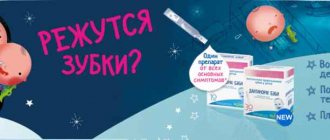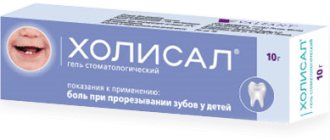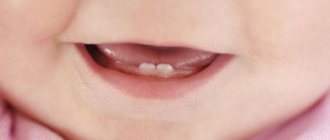Update date: 07/01/2020 14:19:01 77486 Share:
Author: Anastasia Berkovich
*Review of the best according to the editors of simplerule.ru. About the selection criteria. This material is subjective in nature, does not constitute advertising and does not serve as a purchase guide. Before purchasing, consultation with a specialist is required.
Teething in a child is considered one of the main events of the first year of life, as well as an important stage in its physiological development. It becomes a real torture for both him and his parents. The period of teething occurs on average from 6 months to 3 years. But most babies get their first tooth around 8 months.
Parents can suspect the onset of teething by redness and swelling of the gums. Usually after 7-10 days they return to their normal state, but a white stripe appears on their top - the first tooth. Other common symptoms include the following:
- saliva secretion becomes increased;
- gums constantly itch;
- diarrhea occurs;
- loss of appetite;
- body temperature reaches 37.5-38.0 ºC.
Even at this stage, the child constantly puts various objects or his own fingers into his mouth. He sucks and bites them. Most pediatricians consider teething to be a natural physiological process that does not require special medical intervention. And yet, during this period, even if it proceeds without any particular complications, the baby is very physically uncomfortable. And this, in turn, has a bad effect on the child’s nervous system.
In such a situation, children need specially developed drugs that would alleviate their condition. All such products must be safe and tested through rigorous clinical trials. In our review, we have collected the best gels with an analgesic effect, as well as the best homeopathic and organic remedies for teething.
How do medications work?
All drugs that are used to relieve the unpleasant symptoms of teething can be divided into several groups:
- local remedies (gels, ointments, creams);
- anti-inflammatory and painkillers for oral administration in the form of drops;
- homeopathic medicines.
The effect of anesthetic ointments and gels is based on the fact that they most often contain anesthetic substances (for example, lidocaine), which block pain receptors on the surface of the gums. Additionally, they may contain anti-inflammatory ingredients and plant extracts that eliminate inflammatory symptoms during teething. The effect of them occurs almost immediately after application, but the duration of their action is insignificant and lasts up to half an hour.
Painkillers are indicated for use if the child does not have a fever and his general health does not show significant changes.
Anti-inflammatory and analgesic medications are especially effective for pain relief from gums and increased overall body temperature. They act systemically, the effect of their use appears after 30-40 minutes, but lasts up to 12 hours.
Homeopathic remedies contain components of natural origin, which also act on the baby’s entire body, while reducing the symptoms of inflammation of the gum tissue, relieving pain and accelerating the process of cutting baby teeth.
Let's look at each group of drugs in more detail.
Local remedies
Dental anesthetic ointments, gels and gum creams are the most popular remedies for teething symptoms. They can easily be applied to an inflamed and swollen area on the gum, thereby almost immediately relieving the baby’s discomfort. Often, determining which ointment will work best can only be done experimentally, since each child has individual sensitivity to different components of the product.
Kamistad Gel Baby
Kamistad Baby is a combined dental gel for children with local anesthetic, anti-inflammatory and antibacterial effects. It contains lidocaine hydrochloride and chamomile tincture, which ensure rapid penetration of the gel to the painful area and weakening or complete elimination of pain for some time.
Kalgel
Dental gel, the composition of which is a combination of a local anesthetic - lidocaine with the antiseptic cytilperidinium, which is active against most bacteria and fungi. The action of Kalgel begins 1-2 minutes after application and continues for 10-15 minutes. In case of severe pain, the gel can be reapplied, but it is better not to use it more than 6 times a day. It is possible to use the gel not only to facilitate teething, but also to treat thrush in the child’s mouth.
Dentinox gel
Dentinox is a gel to relieve painful teething of baby teeth. The anesthetic effect is due to the presence of lidocaine hydrochloride in the composition. Additionally, Dentinox has an anti-inflammatory effect thanks to chamomile tincture and polidocanol, which inhibit the growth of pathogens. This gel can be used several times a day, its duration of action is 15 minutes. The drug does not contain sugar and does not have a negative effect on teeth.
Cholisal gel
Dental gel, the main components of which are choline salicylate and cetalkonium chloride, which have a pronounced anti-inflammatory, antibacterial and analgesic effect. To relieve pain, simply spread the gel on the inflamed area of the gum. The special structure of the drug holds it on the surface of the mucous membrane, which ensures its relatively long-lasting effect (up to 2-3 hours).
The best gels with an analgesic effect
Analgesics that are used during teething can be divided into 2 main groups. The former contain lidocaine, benzocaine or similar local anesthetics. Others are dominated by natural ingredients.
Kamistad Baby gel
Rating: 4.9
The first nominee in our review was the German gel Kamistad Baby. It contains 2 active components: chamomile flower extract (soothes, relieves inflammation, heals mucous membranes) and polidocanol (cools and distracts the gums during teething). This remedy is suitable for small children (from 3 months), when they experience the first signs of the appearance of baby teeth.
Gel Kamistad Baby is transparent with a yellow-brown tint. Its taste is pleasant - mint-honey. It is placed in an aluminum tube with a narrow thin dispenser neck. When squeezed out, the gel does not spread because it is quite thick. The product is squeezed onto a clean finger or a cotton swab and distributed over the surface of the gums, lightly rubbing. The manipulation can be repeated 2-3 times a day. It is better to do this after feeding or before bed.
According to reviews from parents, Kamistad Baby begins to act quite quickly. Many adults have experienced it themselves, so they note that the gums seem to freeze after applying the gel. And this effect lasts 20-40 minutes. Usually, after applying this product, babies sleep peacefully for 1-1.5 hours, and then begin to act up again. Parents also note that this gel is quite sticky and they do not feel comfortable using it.
Advantages
- lack of lidocaine;
- convenient tube with a dispensing spout;
- pleasant aroma;
- quickly relieves pain.
Flaws
- short term effect.
Kalgel
Rating: 4.8
Polish dental gel Kalgel contains 2 active ingredients: lidocaine (causes local anesthesia) and cetylpyridinium chloride (has an antiseptic effect). With these remedies it is possible to reduce pain and relieve the inflammatory process on the gums during teething. This medicine is suitable for use if the child is already 3 months old.
Kalgel is a homogeneous, soft gel. There are no grains or inclusions in it. Its color is yellow-brown, close to amber. Kalgel's aroma is quite specific. It is packaged in aluminum tubes in quantities of 10 g. It is enough to take a small pea of the product with a clean finger and carefully distribute it over the painful area, lightly massaging the gums. After 20 minutes, Kalgel can be reapplied. You can do such manipulations a maximum of 6 times per day.
The effect of this remedy develops immediately. The lidocaine contained in the product freezes the gums and all negative symptoms temporarily alleviate the child’s condition. However, this pain relief effect does not last very long and after 40-60 minutes the baby begins to experience pain again. It should also be borne in mind that lidocaine is a potentially dangerous substance for children and can cause a number of negative consequences.
Advantages
- quickly relieves pain;
- pleasant organoleptic properties;
- Allowed for children from 3 months.
Flaws
- relieves pain for a short time.
Dentinale Natura gel
Rating: 4.7
Italian gel Dentinail Nature contains 3 natural active ingredients: aloe vera juice, boswellia and chamomile extracts. With Dentinale natura, the gums become less sensitive during teething, and their irritation and inflammation decrease. With this remedy, the period of appearance of baby teeth will be more comfortable and the use of synthetic anesthetics and analgesics will be avoided.
Dentinyl Natura is in an aluminum tube (20 ml). This gel is transparent with a yellowish tint. It has a pleasant, menthol taste. You can apply the medicine using a washed finger. During manipulation, everything should be done very delicately. You can repeat the procedure of applying Dentinyl up to 5 times a day. After this, you should not feed the child or give him anything to drink for half an hour.
From the reviews it follows that Dentinale natura begins to act 5-10 minutes after application. With this remedy, the child quickly falls asleep and can sleep peacefully for more than 2 hours. This drug is used quite economically and with it you can “grow” even a single tooth. This product is safe even if a child swallows it. But in some especially sensitive babies, it can still provoke allergic reactions.
Advantages
- natural components of the composition;
- absence of lidocaine, parabens, sugar;
- pleasant taste characteristics;
- relieves pain quite quickly.
Flaws
- May cause allergies in some.
Baby Doctor gel first teeth
Rating: 4.6
Israeli gel Baby Doctor first teeth contains 5 medicinal plants. Together, these herbal components make it possible to relieve inflammation on the gums, relieve severe pain, and heal the mucous membrane that is damaged during the eruption of baby teeth. This medicine can be used by patients who are already 3 months old.
Gel Baby Doctor is completely transparent and quite thick. It comes in a soft plastic tube. Its taste is slightly sour, herbal, with hints of mint. The gel is recommended to be applied to the child’s gums when the first signs of trouble appear during teething. This is done with a well-washed finger. The manufacturer states that this product is safe if swallowed by children.
Usually the effect of Baby Doctor develops almost immediately and lasts for 3 hours. At this time, the child stops putting fingers and toys into his mouth. This drug clearly eliminates itching on the gums for a while. However, there is no lidocaine in the composition, so this remedy does not have pronounced pain relief. In addition, some parents are confused by the presence of methylparaben in the composition.
Advantages
- the composition is rich in natural ingredients;
- does not contain lidocaine;
- pleasant to use;
- perfectly eliminates itching on the gums.
Flaws
- contains methylparaben.
Dentinox
Rating: 4.5
Another worthy nominee in our review was the German Dentinox gel. It contains 3 active components: chamomile (excellently relieves inflammation), lidocaine (causes local anesthesia), lauromacrogol 600 (enhances the therapeutic effect of lidocaine). It is actively used in pediatrics during teething, during which the gums become inflamed, irritated and very painful.
Dentinox gel is homogeneous, slightly cloudy. Its color is greenish-yellow. The aroma smells of chamomile and menthol. It is packaged in metal tubes in quantities of 10 g. The product can be applied with a clean finger or a cotton swab. It is enough to take a small pea of the product and delicately apply it to the painful area, rubbing lightly. The procedure can be repeated up to 3 times a day. It is correct to do this after feeding and before bedtime.
Despite the presence of lidocaine in the composition, which not all parents favor, there are many positive reviews about Dentinox. The product begins to act 2-3 minutes after it is distributed over the area where teething occurs. Its analgesic effect is enough for the child to fall asleep peacefully. Usually the drug is well tolerated, but in some babies it can provoke allergies.
Advantages
- effectively eliminates pain;
- has an antiseptic effect;
- pleasant to use;
- the action develops 2-3 minutes after application.
Flaws
- may cause an allergic rash.
Holisal
Rating: 4.5
Polish gel Cholisal contains 2 active ingredients: choline salicylate (locally eliminates pain, inflammation, hyperthermia), cetalkonium chloride (has an antiseptic effect). The adhesive base of the product contains ethyl alcohol, so the effect when applying Cholisal develops quickly, and the active ingredients themselves remain on the mucous membrane longer. This product is approved for children over 1 year of age.
You can buy 10 or 15 g of Cholisal. It is placed in metal tubes. The gel is homogeneous, transparent, colorless. The aroma is anise, pronounced. When teething, a strip of the product (about 0.5 cm) is squeezed onto a clean finger and gently rubbed into the painful area, gently massaging the gums. It is allowed to use Cholisal 2-3 times a day.
The child usually calms down 3-5 minutes after applying the product to the area where teething occurs. The pain relief effect lasts differently for everyone, but it usually lasts 2-8 hours. However, adults note that most often there is a short-term mild burning sensation at the sites where the drug is applied. Many people like that this product does not contain lidocaine and sugar.
Advantages
- good combination of active ingredients;
- lack of sugar and lidocaine in the composition;
- comfortable gel to use;
- quickly relieves pain.
Flaws
- A slight burning sensation is felt immediately after application.
Pansoral first teeth
Rating: 4.5
French oral gel Pansoral first teeth contains liquid extracts of chamomile, marshmallow, saffron, and Irish moss among its active ingredients. Has anti-inflammatory, analgesic, antimicrobial effects. This product does not contain lidocaine and is suitable for babies from 4 months.
Pansoral first teeth is sold in soft tubes of 15 ml. It is a transparent gel with a yellowish tint. The product has no smell. The consistency is moderately liquid. The product is easily squeezed out of the tube and is well distributed over the gums. Apply the medicine with a clean finger and lightly massage the painful area. The manipulation is repeated as necessary.
Parents report that in the beginning it is quite difficult to get used to applying this product correctly. But when this begins to work out, the analgesic effect becomes more pronounced. From the reviews it follows that Pansoral is consumed very economically. But some parents are confused that this product contains parabens, and also that there are no instructions in Russian.
Advantages
- contains many medicinal plants;
- pleasant gel consistency;
- when applied correctly, it provides excellent pain relief;
- economically used.
Flaws
- contains parabens;
- no instructions in Russian.
Drops for oral administration
Preparations for oral administration in the form of drops are represented by antihistamines, which help relieve swelling of the mucous membranes, thereby eliminating discomfort.
Fenistil
Fenistil drops relieve swelling of the oral and nasal mucosa, thereby reducing unpleasant symptoms during teething such as pain and difficulty in nasal breathing. It is possible to use the drug up to three times a day.
Parlazin
Another drug from the group of antiallergic drugs that can be used for severe signs of the appearance of baby teeth. Parlazin drops have a long-lasting effect and are used only once a day. The drug reduces the permeability of the vascular wall, eliminates swelling of the mucous membranes, and improves breathing through the nose.
how to help with teething
I want to share my experience...
In the life of every baby and his parents, there comes a time when temporary (or baby) teeth erupt and they are replaced with permanent ones. And every parent rejoices at the appearance of the first and subsequent teeth. But sometimes these happy moments are overshadowed by not entirely pleasant teething symptoms. These include excessive drooling, soreness (which makes children terribly capricious and sleep poorly), in the worst case, fever, diarrhea and diathesis.
Well, it’s these unpleasant symptoms that I would like to talk about, because... I came face to face with this.
Excessive drooling and painful sensations: all this has already been chewed 1000 times on all forums, but I’ll just write how I saved myself. Dantinorm baby dose/1 ml, 10 pcs. and Viburkol suppositories (1 at night, if the child is excessively restless) - but suppositories can also be used according to the instructions. + sometimes used Kalgel (when the baby completely refused to eat due to severe pain). And of course, don’t forget to wipe your baby’s face with soft wipes and wash with plain water without soap to avoid severe irritation in the chin, cheeks and neck (since saliva contains enzymes and is a strong irritant for the baby’s skin).
Temperature: if the temperature is not high (within 38.0), you can get by with the same excellent Viburkol suppositories (well, according to the instructions, of course). But if the temperature is higher, then monitor the child’s condition. Dental fever most often occurs when 2 or more teeth are being cut, there should be no symptoms of a cold (i.e. cough, yellow-green snot), make sure that the baby does not have otitis media - on the auricle, in front of the opening of the external auditory canal, there is a projection called the tragus. Pressure on the tragus causes, in the presence of otitis, a significant increase in pain, provoking a high-pitched cry in the child. Every parent can check for the presence of this symptom, and a positive response is a reason to immediately consult a doctor (at the moment of the eruption of the 4th and 5th teeth - children in the primary occlusion have 5 teeth on each side - children can pull themselves by the ear - this may suggest an incipient otitis). Well, of course, you shouldn’t rule out the presence of hidden infections and it’s better to take a clinical blood and urine test. It is worth lowering the temperature by alternating Panadol and Nurofen (according to the instructions) and giving more fluids. Temperature during teething, based on experience, can be 3-4 days, or up to a week. If you turned to a pediatrician and ruled out all possible diseases in your baby, then weigh the pros and cons before giving your baby antibiotics, because Many pediatricians, playing it safe, prescribe antibiotics from the 3rd day of fever, and on the 7th day, 5 or more teeth erupt.
Diarrhea and diathesis: changes in the consistency and frequency of stool during teething are not a rare phenomenon, especially in children with increased salivation. Because an increase in the amount of swallowed saliva increases intestinal motility and dilutes the enzyme composition of the stomach. Thus, the baby’s stool becomes mushy and the frequency reaches 4-6 times a day, and this does not mean that the baby goes to the toilet fully every time (1-2 times fully, and 4-5 times he “jumps up”, or even not I know what to call it). If this process lasts more than 3-4 days and you did nothing, then the pancreas and intestines begin to suffer (irritable bowel syndrome develops) - the stool becomes green with an admixture of mucus and an unpleasant odor. Therefore, it is better to start immediately helping your baby cope with this symptom.
1) Enterol 2 times a day an hour before meals - 5 days;
2) Enterosgel 4 times a day an hour before meals (if the baby does not eat it, you can dilute it with espumizan) - 2-3 days, until the stool returns to normal;
3) Creon 3 times a day, 1/3 capsule with meals - 10 days;
4) Bifiform 1 day - 5 days.
Well, diet: 1) Dairy-free porridge (rice, buckwheat, multigrain)
2) Rice soup (rice, potatoes, carrots)
Turkey, beef, potatoes
3) Rusks, dried apples, baked apples, bananas
4) Kissels, compotes (not made from dried fruits), chamomile tea, rose hips
And there is also an excellent ready-made carrot-rice broth from Hipp “Ors-200” - to restore the water-salt balance.
Under no circumstances should you give dairy products and sweets, as well as fruits and vegetables with a laxative effect, you will only worsen the situation.
Well, get tested for dysbacteriosis just in case.
Diathesis (from the Greek diáthesis - predisposition), a congenital anomaly of the body's metabolic processes, in which the functions and metabolism of the body come into a state of long-term unstable equilibrium, which is expressed by peculiar pathological reactions and diseases. Hereditary predisposition is essentially the result of a peculiar accumulation in previous generations of properties created in the body both from exposure to unfavorable environmental conditions and associated with congenital anomalies of the internal environment of the body. The mechanism of development of D. is closely related to the autonomic nervous system and internal secretion. When environmental conditions worsen (malnutrition, diet, disease of the body), with functional disorders of the central or autonomic nervous system, neuroregulatory mechanisms cannot ensure the correct function of organs and metabolism, as a result of which the body’s adaptability to the environment decreases, its reactivity changes, there is a predisposition to certain diseases. With D., even physiological stimuli and ordinary living conditions can cause pathological reactions and lead to illness.
Therefore, even during teething, the manifestation of diathesis on the skin is not excluded. We help here too: - Fenistil or Zyrtec 5 drops 1 time per day
— bath with a sequence (only in case of positive dynamics when taking these baths)
— Bepanten ointment or baby moisturizer (if diathesis is dry)
This information is not a reason not to contact specialists. Approach the treatment of your children wisely and intuitively. No doctor knows or can study your child in 10-30 minutes of appointment. Observe and study the behavior and habits of the baby, whether he is healthy or sick.
Don’t get sick and grow up strong and smart!!!
Homeopathic medicines
Pediatric homeopathy is represented by a small number of remedies. All of them contain only natural ingredients that have a pronounced anti-inflammatory and analgesic effect.
Ointment Traumeel S
The most popular homeopathic remedy with an anti-inflammatory effect is Traumeel S. When teething, it is used in the form of an anesthetic ointment. Herbal ingredients can relieve pain, relieve inflammation and swelling of the gums. To achieve maximum effect, it is enough to spread a thin layer of ointment on the oral mucosa 2-3 times a day.
Dentinorm Baby drops
Homeopathic drops for teething pain Dentinorm Baby produced by Boiron (France) are a multicomponent drug with a combined effect. The ingredients included in its composition eliminate the unpleasant sensations accompanying the appearance of the first teeth. Drops are available in convenient containers containing one dose of medication, which minimizes the risk of overdose. The course of administration is only 3 days, 2-3 doses per day.
«
Despite the safety of products used to relieve signs of teething, they should not be used without first consulting a pediatrician. Like any other medications, they have their contraindications and side effects that should be kept in mind.









